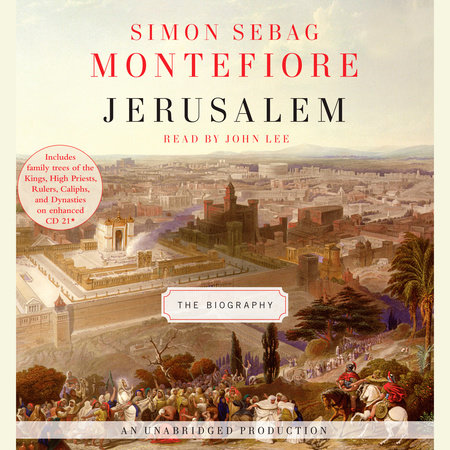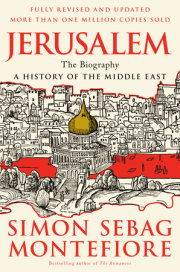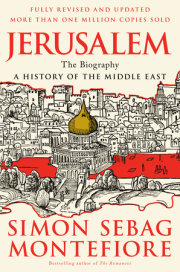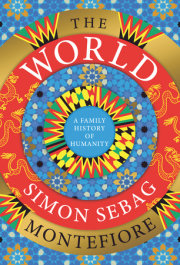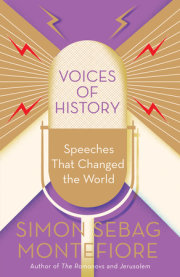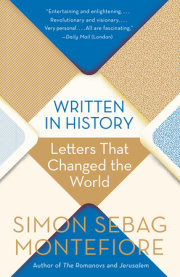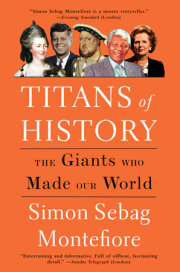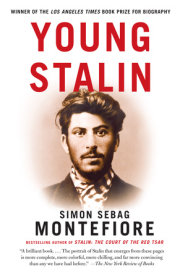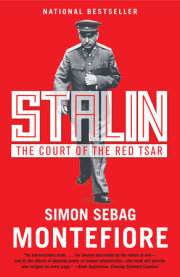Excerpted from the Preface
The history of Jerusalem is the history of the world, but it is also the chronicle of an often penurious provincial town amid the Judaean hills. Jerusalem was once regarded as the centre of the world and today that is more true than ever: the city is the focus of the struggle between the Abrahamic religions, the shrine for increasingly popular Christian, Jewish and Islamic fundamentalism, the strategic battlefield of clashing civilizations, the front line between atheism and faith, the cynosure of secular fascination, the object of giddy conspiracism and internet mythmaking, and the illuminated stage for the cameras of the world in the age of twenty-four-hour news. religious, political and media interest feed on each other to make Jerusalem more intensely scrutinized today than ever before.
Jerusalem is the Holy City, yet it has always been a den of superstition, charlatanism and bigotry; the desire and prize of empires, yet of no strategic value; the cosmopolitan home of many sects, each of which believes the city belongs to them alone; a city of many names—yet each tradition is so sectarian it excludes any other. This is a place of such delicacy that it is described in Jewish sacred literature in the feminine— always a sensual, living woman, always a beauty, but sometimes a shameless harlot, sometimes a wounded princess whose lovers have forsaken her. Jerusalem is the house of the one God, the capital of two peoples, the temple of three religions and she is the only city to exist twice—in heaven and on earth: the peerless grace of the terrestrial is as nothing to the glories of the celestial. The very fact that Jerusalem is both terrestrial and celestial means that the city can exist anywhere: new Jerusalems have been founded all over the world and everyone has their own vision of Jerusalem. Prophets and patriarchs, Abraham, David, Jesus and Muhammad are said to have trodden these stones. The Abrahamic religions were born there and the world will also end there on the Day of Judgement. Jerusalem, sacred to the Peoples of the Book, is the city of the Book: the Bible is, in many ways, Jerusalem’s own chronicle and its readers, from the Jews and early Christians via the Muslim conquerors and the Crusaders to today’s American evangelists, have repeatedly altered her history to fulfil biblical prophecy.
When the Bible was translated into Greek then Latin and English, it became the universal book and it made Jerusalem the universal city. Every great king became a David, every special people were the new Israelites and every noble civilization a new Jerusalem, the city that belongs to no one and exists for everyone in their imagination. And this is the city’s tragedy as well as her magic: every dreamer of Jerusalem, every visitor in all ages from Jesus’ Apostles to Saladin’s soldiers, from Victorian pilgrims to today’s tourists and journalists, arrives with a vision of the authentic Jerusalem and then is bitterly disappointed by what they find, an ever-changing city that has thrived and shrunk, been rebuilt and destroyed many times. But since this is Jerusalem, property of all, only their image is the right one; the tainted, synthetic reality must be changed; everyone has the right to impose their “Jerusalem” on Jerusalem—and, with sword and fire, they often have.
Ibn Khaldun, the fourteenth-century historian who is both participant and source for some of the events related in this book, noted that history is so “eagerly sought after. The men in the street aspire to know it. Kings and leaders vie for it.” This is especially true for Jerusalem. It is impossible to write a history of this city without acknowledging that Jerusalem is also a theme, a fulcrum, a spine even, of world history. At a time when the power of Internet mythology means that the hi-tech mouse and the curved sword can both be weapons in the same fundamentalist arsenal, the quest for historical facts is even more important now than it was for Ibn Khaldun.
A history of Jerusalem must be a study of the nature of holiness. The phrase “Holy City” is constantly used to describe the reverence for her shrines, but what it really means is that Jerusalem has become the essential place on earth for communication between God and man.
We must also answer the question: Of all the places in the world, why Jerusalem? The site was remote from the trade routes of the Mediterranean coast; it was short of water, baked in the summer sun, chilled by winter winds, its jagged rocks blistered and inhospitable. But the selection of Jerusalem as the Temple city was partly decisive and personal, partly organic and evolutionary: the sanctity became ever more intense because she had been holy for so long. Holiness requires not just spirituality and faith but also legitimacy and tradition. A radical prophet presenting a new vision must explain the centuries that have gone before and justify his own revelation in the accepted language and geography of holiness—the prophecies of earlier revelations and the sites already long revered. Nothing makes a place holier than the competition of another religion.
Many atheistic visitors are repelled by this holiness, seeing it as infectious superstition in a city suffering a pandemic of righteous bigotry. But that is to deny the profound human need for religion without which it is impossible to understand Jerusalem. Religions must explain the fragile joys and perpetual anxieties that mystify and frighten humanity: we need to sense a greater force than ourselves. We respect death and long to find meaning in it. As the meeting-place of God and man, Jerusalem is where these questions are settled at the Apocalypse—the End of Days, when there will be war, a battle between Christ and anti-Christ, when the Kaaba will come from Mecca to Jerusalem, when there will be judgment, resurrection of the dead and the reign of the Messiah and the Kingdom of Heaven, the New Jerusalem. All three Abrahamic religions believe in the Apocalypse, but the details vary by faith and sect. Secularists may regard all this as antique gobbledegook, but, on the contrary, such ideas are all too current. In this age of Jewish, Christian and Muslim fundamentalism, the Apocalypse is a dynamic force in the world’s febrile politics.
Death is our constant companion: pilgrims have long come to Jerusalem to die and be buried around the Temple Mount to be ready to rise again in the Apocalypse, and they continue to come. The city is surrounded by and founded upon cemeteries; the wizened body-parts of ancient saints are revered—the desiccated blackened right hand of Mary Magdalene is still displayed in the Greek Orthodox Superior’s Room in the Church of the Holy Sepulchre. Many shrines, even many private houses, are built around tombs. The darkness of this city of the dead stems not just from a sort of necrophilia, but also from necromancy: the dead here are almost alive, even as they await resurrection. The unending struggle for Jerusalem—massacres, mayhem, wars, terrorism, sieges and catastrophes—have made this place into a battlefield, in Aldous Huxley’s words the “slaughterhouse of the religions,” in Flaubert’s a “charnel-house.” Melville called the city a “skull” besieged by “armies of the dead”; while Edward Said remembered that his father had hated Jerusalem because it “reminded him of death.”
Copyright © 2012 by Simon Sebag Montefiore. All rights reserved. No part of this excerpt may be reproduced or reprinted without permission in writing from the publisher.

